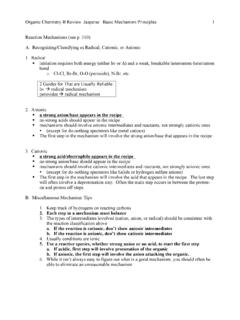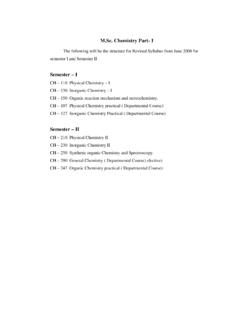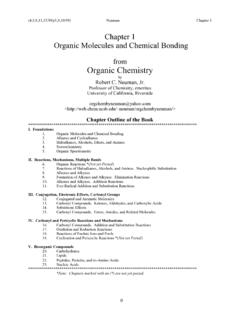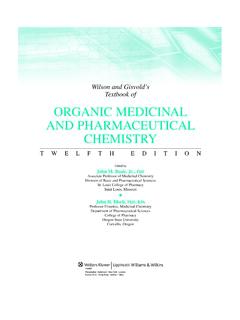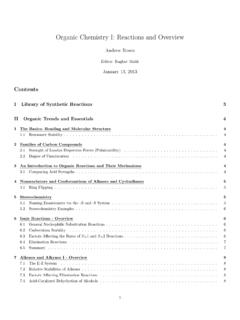Organic chemistry ii
Found 10 free book(s)Review of Organic Chem II - Minnesota State University ...
web.mnstate.eduOrganic Chemistry II Review Jasperse Some Fundamental Stability/Reactivity Principles 3 2. Product Stability/Reactivity: The more stable the product, the more favorable its formation will be.In terms of rates, this means that the more stable the product, the faster the reaction.
M.Sc. Chemistry Part- I Semester – I Semester – II
www.unipune.ac.inM.Sc. Part – II :- ORGANIC CHEMISTRY SEMESTER : - III – 1. CH – 350 Organic Reaction Mechanism 2. CH – 351 Spectroscopic Methods in structure Determination 3. CH – 352 A Organic Stereochemistry. B. Green Chemistry, Microwave reactions. 4. CH – 353 Pericyclic Reactions, Free radicals and Photo Chemistry. ...
A SELF-STUDY GUIDE TO THE PRINCIPLES OF ORGANIC …
www.bookpump.comlanguage, organic chemistry. By studying this book, students struggling with organic chemistry will be able to grasp the key concepts easily. Some students taking organic chemistry are very scared of the class, but this central science sub-ject is a requirement for chemistry majors, biology majors or many more related majors. It is intended
from Organic Chemistry
chemistry.ucr.eduOrganic Spectrometry II. Reactions, Mechanisms, Multiple Bonds 6. Organic Reactions *(Not yet Posted) 7. ... In contrast, your organic chemistry instructors will present a course in which each new topic uses information from previous topics to raise your understanding of organic chemistry to successively higher levels.
NOMENCLATURE IN ORGANIC CHEMISTRY
scilearn.sydney.edu.auNOMENCLATURE IN ORGANIC CHEMISTRY Contents 1. INTRODUCTION 3 2. HYDROCARBONS 3 (i) Alkanes 3 A. Unbranched Chains 3 B. Unbranched chains 4 (ii) Alkenes 5 A. One double bond 5 B. More than one double bond 5 C. E/Z Isomers in Alkenes 6 (iii) Alkynes 8 (iv) Combined Alkenes and Alkynes 8 (v) Cyclic Hydrocarbons 9 3.
Wilson and Gisvold’s Textbook of ORGANIC MEDICINAL AND ...
downloads.lww.comChemistry, 12th Edition, have access to the following additional resources: • The answers to the review questions found in the book In addition, purchasers of the text can access the searchable Full Text On-line by going to the Wilson and Gisvold’s Textbook of Organic Medicinal and Pharmaceutical Chemistry, 12th Edition, Web site
B. Sc. II YEAR ORGANIC CHEMISTRY -II - UOU
uou.ac.inORGANIC CHEMISTRY-II BCHCH-202 UTTARAKHAND OPEN UNIVERSITY Page 6 Step 5. Combine the name and location for other groups, the hydroxyl group location, and the longest chain into the final name. Step 6. If there are more than one –OH group do not remove the –e from the suffix, but add a di- or tri- prefix to the –ol suffix. ...
ACS Examination guide (Selected Questions) Organic ...
www.mdc.eduOrganic Chemistry Nomenclature 1. What is the IUPAC names for this compound? a) 1-tert-butyl-2-butanol b) 5,5-dimethyl-3-hexanol ... II > IV > I > III B) III > I > IV > II C) III > IV > I > II D) II > I > IV > III Rank the following in order of basicity. (1 – least basic, 3 – most
organic chemistry: SN2, E2, SN1, E1 - freelance-teacher.com
www.freelance-teacher.comorganic chemistry: S N2, E2, S N1, E1 1 www.freelance-teacher.com S N2 S N1/E1 S N1 and E1 have identical rate determining steps, so they generally occur simultaneously and have the same properties. E2 S N2 and E2 S N1/E1 mechanism one step—this single step is the rate-determining step (RDS) two steps—RDS is formation of carbocation
Organic Chemistry I: Reactions and Overview
sites.tufts.eduPart II Organic Trends and Essentials 1 The Basics: Bonding and Molecular Structure 1.1 Resonance Stability 1. The more coalenvt bonds a structure has, the more stable it is 2. Charge separation (formal charges) decreases stability 3. Negative charges on the more electronegative elements and positive charges on the more electropositive elements are
